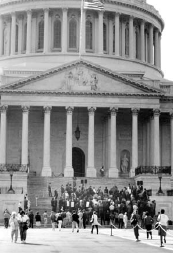
Chapter 71 Rights
Part of the statutes that were eliminated included Chapter 71 of Title 5, the crucial section granting federal workers the right to union representation and collective bargaining. Without that, NATCA couldn’t exist. Congress also stripped away what little remaining authority the Agency’s unions had to negotiate by directing the FAA to work “in consultation” with them. This language gave the Agency free rein to simply announce sweeping changes before unilaterally implementing them.
 |
| Ken Montoya and his assistant Stacy Trigler. |
Unless the unions could persuade Congress to reinstate Chapter 71 rights before the April 1 deadline for FAA reform, they would lose everything. Although FAA management assured NATCA that it would continue to bargain in good faith, the Union was taking no chances.
“We do not exist because they allow us to exist,” then-President Krasner said. “We exist because we have a right to exist.”
The fate of NATCA now rested on the ability of Montoya and NATCA leadership to lobby Congress and the White House. NATCA fought two battles. First, the Union fought for the inclusion of language restoring workers’ rights in a continuing resolution (the only way it could get legislation enacted in time). The second battle entailed strengthening the “in consultation” phraseology to “shall negotiate.” Without this language change, even if Chapter 71 rights were reinstated, the FAA could still develop procedures before bargaining with its unions.
To expand its lobbying efforts, NATCA joined forces with the FAA’s two other major unions — the National Association of Air Traffic Specialists (NAATS) and the Professional Airways Systems Specialists (PASS, which is presently known as the Professional Aviation Safety Specialists) — to form the Aviation Labor Coalition. At the same time, Michael McNally, who’d won election as executive vice president in 1994, launched another offensive by turning to the AFL-CIO for help.
 |
| Grass roots legislative activism helped save the union during NATCA’s battle to regain key rights. |
Coalition members convinced President Clinton to engage on the issue. This was the first a U.S. president became involved in an air traffic control labor issue since the PATCO strike in 1981. During a White House meeting, Montoya and Krasner pleaded their case with Secretary of Transportation and representatives from the FAA, Transportation Department, and Office of Management and Budget. The Clinton administration agreed to insist on reinstating the workers’ rights, but NATCA hit a roadblock with Senate Appropriations Committee Chairman Mark Hatfield, R-Ore., who refused to include Chapter 71 language in a continuing resolution without the approval of Senate Commerce Committee Chairman John McCain, R-Ariz.
McCain was drafting the FAA Reauthorization Act of 1996, which outlined the parameters of Agency reform, and he demanded union support for his bill before giving Hatfield the green light. NATCA liked many provisions of the act with one exception — it included the same “in consultation” language as the FAA reform measure that Congress had passed the previous fall. After McCain’s staff verbally agreed to change the language to “shall negotiate,” Montoya and the Union’s National Legislative Committee (NLC) endorsed the reauthorization bill.
By mid-March, McCain still hadn’t given Hatfield the green light. In response, Krasner lead an army of grass roots NATCAvists organized by the NLC and flooded the senator’s phone lines.
“They shut down McCain’s office with incoming calls,” Montoya recalls. At the 11th hour, on March 29, McCain gave his OK to Hatfield. On the last business day before NATCA would cease to function, Congress passed a continuing resolution that included three special items: aid for Bosnia, Midwest flood relief, and restoration of Chapter 71 rights. Shortly after, NATCA pagers across the nation started beeping.
McCain’s FAA Reauthorization Act became law the following October. As his staff members had promised, it included the “shall negotiate” language.

